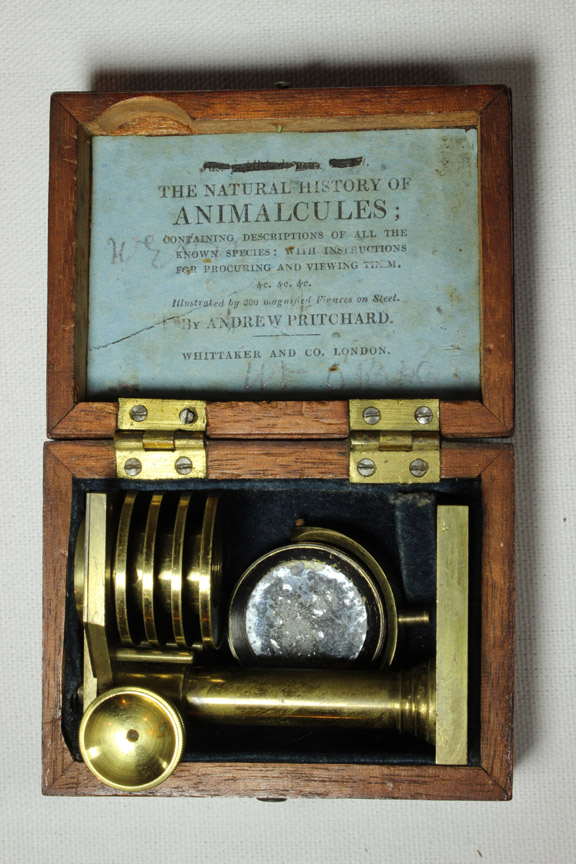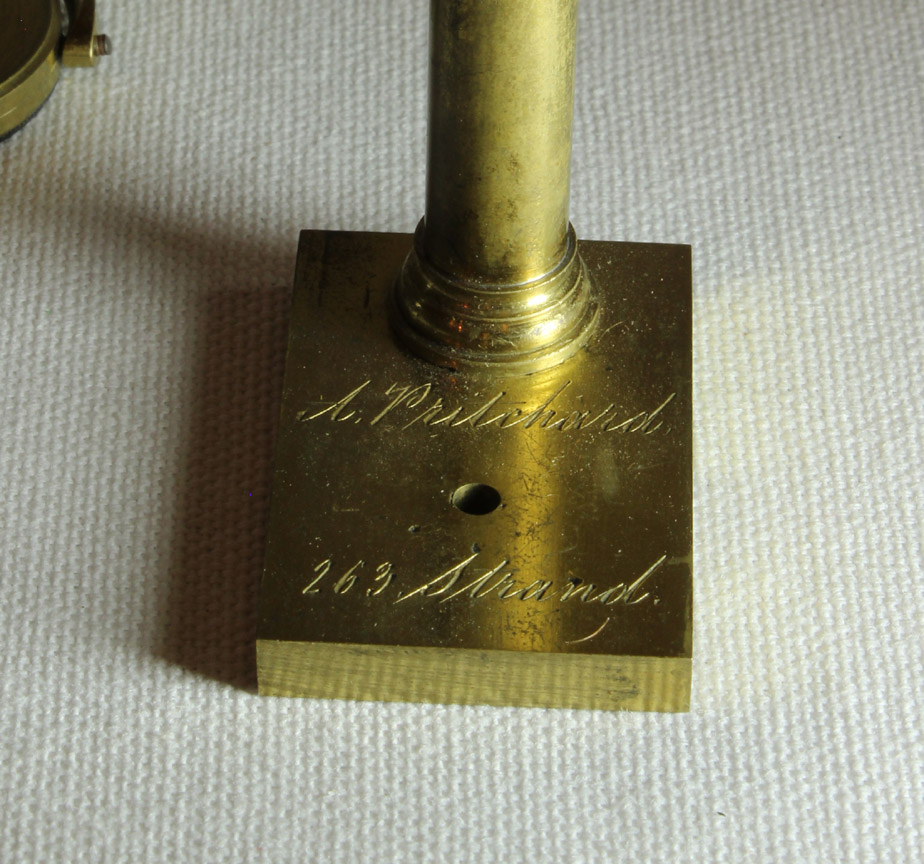'NEW POCKET MICROSCOPE':
c. 1837
SIGNED ON THE FOOT: 'A. Pritchard 263 Strand'
DESCRIPTION

 This is is a very small miniature pocket microscope. The "NEW POCKET MICROSCOPE" signed on the base in script: "A. Pritchard 263 Strand" . Acccording to Bracegirdle, he was at this address only from 1836-9. This microscope from the 2nd qtr of the 19th C, has four screw on objectives and stores in its original mahogany case with blue velvet interior. In the lid, unlike some other examples is an ad for Pritchard's book "The Natural History of Animalcules" There are four lenses which screw into each other for storage but are intended to be used seperately, and are signed lightly on the back: 10=100, 20=400, 40=1600, and 100 = 10,000. All but the lowest power objective have diaphragms to stop them down. The lowest power lens has a scuff on the top in the center, and the 40 a chip near the edge of the field of view. All are quite usable. Focus is by Rack and pinion. There is a U-shaped stage clip which fits into two holes on the back of the stage and can slide up to accomodate a fairly thick item like a live box. There is a a hole on each of the front sides of the stage which also goes through the stage clip, to accomodate a stage forceps (not present). A miniature brass hand forceps or tweezer is included. The substage mirror is gimbaled. The objective fit into a split ring on the microscope even though they screw into each other; this is much more convenient for changing magnifications. The microscope is only 2 1/2 inches (7 1/2 cm) high with a single lens in the fully down position. The base measures 1 5/8 x 1 1 /8 inches. Condition excellent except for loss of silver to the mirror and some pencilled writing on the inside lid. This microscope was described in Pritchard's The Microscopic Cabinet on pages 242 to 243 about his new pocket microscope and its virtue of focusing via moving the objective rather than the stage, moving the objective closer to the light source. The little forceps measures 2 1/8 inches long
This is is a very small miniature pocket microscope. The "NEW POCKET MICROSCOPE" signed on the base in script: "A. Pritchard 263 Strand" . Acccording to Bracegirdle, he was at this address only from 1836-9. This microscope from the 2nd qtr of the 19th C, has four screw on objectives and stores in its original mahogany case with blue velvet interior. In the lid, unlike some other examples is an ad for Pritchard's book "The Natural History of Animalcules" There are four lenses which screw into each other for storage but are intended to be used seperately, and are signed lightly on the back: 10=100, 20=400, 40=1600, and 100 = 10,000. All but the lowest power objective have diaphragms to stop them down. The lowest power lens has a scuff on the top in the center, and the 40 a chip near the edge of the field of view. All are quite usable. Focus is by Rack and pinion. There is a U-shaped stage clip which fits into two holes on the back of the stage and can slide up to accomodate a fairly thick item like a live box. There is a a hole on each of the front sides of the stage which also goes through the stage clip, to accomodate a stage forceps (not present). A miniature brass hand forceps or tweezer is included. The substage mirror is gimbaled. The objective fit into a split ring on the microscope even though they screw into each other; this is much more convenient for changing magnifications. The microscope is only 2 1/2 inches (7 1/2 cm) high with a single lens in the fully down position. The base measures 1 5/8 x 1 1 /8 inches. Condition excellent except for loss of silver to the mirror and some pencilled writing on the inside lid. This microscope was described in Pritchard's The Microscopic Cabinet on pages 242 to 243 about his new pocket microscope and its virtue of focusing via moving the objective rather than the stage, moving the objective closer to the light source. The little forceps measures 2 1/8 inches long
HISTORY OF THE 'NEW POCKET MICROSCOPE'
Acccording to Bracegirdle, he was at this address only from 1836-9. This microscope was described in Pritchard's 'The Microscopic Cabinet' on pages 242 to 243 about his new pocket microscope and its virtue of focusing via moving the objective rather than the stage, moving the objective closer to the light source. Andrew Pritchard was an accomplished dealer in microscopes and microscope slides. His slides are frequently smaller than the standard size but he also sold standard size slides. One of the hallmarks of Pritchard slides is that he often sold specimens sandwhiched between two glass slides held together by red sealing wax. He also often sold small slides in sets contained in small maroon-colored felt lined cases. It is likely that he factored them in from slide makers like Mr Darker who invented the technique used with these slide. Often his small slides seem to be labelled with names cut out of printed pages.


 This is is a very small miniature pocket microscope. The "NEW POCKET MICROSCOPE" signed on the base in script: "A. Pritchard 263 Strand" . Acccording to Bracegirdle, he was at this address only from 1836-9. This microscope from the 2nd qtr of the 19th C, has four screw on objectives and stores in its original mahogany case with blue velvet interior. In the lid, unlike some other examples is an ad for Pritchard's book "The Natural History of Animalcules" There are four lenses which screw into each other for storage but are intended to be used seperately, and are signed lightly on the back: 10=100, 20=400, 40=1600, and 100 = 10,000. All but the lowest power objective have diaphragms to stop them down. The lowest power lens has a scuff on the top in the center, and the 40 a chip near the edge of the field of view. All are quite usable. Focus is by Rack and pinion. There is a U-shaped stage clip which fits into two holes on the back of the stage and can slide up to accomodate a fairly thick item like a live box. There is a a hole on each of the front sides of the stage which also goes through the stage clip, to accomodate a stage forceps (not present). A miniature brass hand forceps or tweezer is included. The substage mirror is gimbaled. The objective fit into a split ring on the microscope even though they screw into each other; this is much more convenient for changing magnifications. The microscope is only 2 1/2 inches (7 1/2 cm) high with a single lens in the fully down position. The base measures 1 5/8 x 1 1 /8 inches. Condition excellent except for loss of silver to the mirror and some pencilled writing on the inside lid. This microscope was described in Pritchard's The Microscopic Cabinet on pages 242 to 243 about his new pocket microscope and its virtue of focusing via moving the objective rather than the stage, moving the objective closer to the light source. The little forceps measures 2 1/8 inches long
This is is a very small miniature pocket microscope. The "NEW POCKET MICROSCOPE" signed on the base in script: "A. Pritchard 263 Strand" . Acccording to Bracegirdle, he was at this address only from 1836-9. This microscope from the 2nd qtr of the 19th C, has four screw on objectives and stores in its original mahogany case with blue velvet interior. In the lid, unlike some other examples is an ad for Pritchard's book "The Natural History of Animalcules" There are four lenses which screw into each other for storage but are intended to be used seperately, and are signed lightly on the back: 10=100, 20=400, 40=1600, and 100 = 10,000. All but the lowest power objective have diaphragms to stop them down. The lowest power lens has a scuff on the top in the center, and the 40 a chip near the edge of the field of view. All are quite usable. Focus is by Rack and pinion. There is a U-shaped stage clip which fits into two holes on the back of the stage and can slide up to accomodate a fairly thick item like a live box. There is a a hole on each of the front sides of the stage which also goes through the stage clip, to accomodate a stage forceps (not present). A miniature brass hand forceps or tweezer is included. The substage mirror is gimbaled. The objective fit into a split ring on the microscope even though they screw into each other; this is much more convenient for changing magnifications. The microscope is only 2 1/2 inches (7 1/2 cm) high with a single lens in the fully down position. The base measures 1 5/8 x 1 1 /8 inches. Condition excellent except for loss of silver to the mirror and some pencilled writing on the inside lid. This microscope was described in Pritchard's The Microscopic Cabinet on pages 242 to 243 about his new pocket microscope and its virtue of focusing via moving the objective rather than the stage, moving the objective closer to the light source. The little forceps measures 2 1/8 inches long
